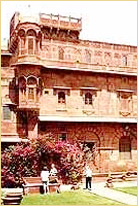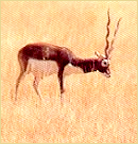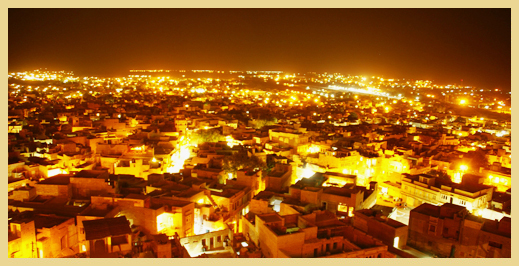| |
|
|
|
|
Pokhran:
Pokhran is a sparsely populated area consisting mainly
of scrub and sand. This place suddenly hogged the
international spotlight when the Indian government
detonated nuclear devices here on 18th May 1974,
ironically code-named ĎThe Buddha Smilesí. The tour to
Pokhran fort is worth mentioning. The Pokhran fort is a
yellow sandstone fort which is over 4 centuries old and
was constructed by the Marwar Thakur (local chieftain) Rao
Maldeo who reigned from 1532-1584. The Pokhran Museum
housed inside the fortís premises is smallish and contains
an assortment of weapons, paintings, pottery and the
costumes which the Maharajas wore. Also displayed are the
little games the royal family played during their leisure
such as dominoes and dice. |
 |
|
Desert National Park:
The Desert National Park of Jaisalmer is a true reflection
of the ecosystem and flora and fauna of the Thar Desert.
It was established in 1980. The substantial part of the
park is on a landscape, which comprises of lakebed of
extinct salt lakes and thorny scrubs. It is a wonder in
itself that how come living organisms flourish in these
harsh conditions. The months of October to April are just
right for wildlife tours to the Desert National Park
Jaisalmer. The only thing that foreign tourists must keep
in mind while embarking on wildlife tours to Desert
National Park is that they must get special permits issued
from the local forest office. |
 |
|
Akal Fossil Park:
Millions of years ago Jaisalmer was submerged by the
ocean, and the discovery of sea shells here emphasizes
that belief. Spread over 21 hectares, the Akal Wood Fossil
Park is a unique experience. The reserve or park has been
dated approximately to be 180 million years ago. The wood
fossils present in the Akal Wood Fossil Park are a result
of the fossilization of the trees that once occupied this
area millions of years ago. |
 |
|
Lodurva Temple:
Tour the medieval Lodurva temples located at a distance of
15 kilometer, northwest of the Jaisalmer city. Lodurva was
the ancient capital of the Bhattis. The ancient town that
is in ruins has some beautiful Jain temples in its
complex. The Parshvanath Temple is the main temple that
was destroyed in 1152 but was reconstructed again in 1675
and 1687. Built from yellow sandstone- the Jain temples
still exhibit their old glory. The walls are adorned with
pictures of Lord Parshvanath, the 23rd Jain Tirthankar.
The temple with mind-blowing stone work and minute
sculpture will definitely make you to admire the wonderful
piece of art which was constructed ages back. |
 |
|
|
|

